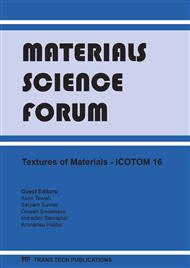[17]
T Watanabe, Grain boundary engineering in textured materials, Proc.ICOTOM-11, (1996), 1309-1318 .
Google Scholar
[18]
T Watanabe, H Fujii, H Oikawa, K I Arai, Grain boundaries in rapidly solidified and annealed Fe-6.5mass%Si polycrystalline ribbons with high ductility, Acta Met, 37 (1989), 941-952.
DOI: 10.1016/0001-6160(89)90021-7
Google Scholar
[19]
T Watanabe, K I Arai, K Yoshimi, H Oikawa, Phil Mag. Letters, 59 (1989), 47-52.
Google Scholar
[20]
A. Garbacz, M. W. Grabski: Modelling of CSL boundaries distribution in polycrystals, Scripta Met, 23 (1989), 1369-1374.
DOI: 10.1016/0036-9748(89)90061-6
Google Scholar
[21]
V Y Gertsman, A P Zhilyaev, A L Pshenichniuk, R Z Variev, Modelling of grain boundary misorientation spectrum in polycrystals with crystallographic texture, Acta Met Mater, 40(1992), 1433-1441.
DOI: 10.1016/0956-7151(92)90445-k
Google Scholar
[22]
A Garbacz, M W Grabski, The relationship between texture and CSL boundaries distribution in polycrystalline materials, I, II, Acta Met Mater, 41 (1993), 409-473, 475-483.
DOI: 10.1016/0956-7151(93)90076-5
Google Scholar
[23]
L Zuo, T Watanabe, C Esling, A theoretical approach to grain boundary character distribution (GBCD) in textured polycrystalline materials, Z Metallkde, 85 (1994), 554-558.
DOI: 10.1515/ijmr-1994-850804
Google Scholar
[24]
L C Lim, R Raj, On the distribution of S for grain boundaries in polycrystalline nickel prepared by strain-annealing technique, Acta Met, 32 (1985), 1177-1181.
DOI: 10.1016/0001-6160(84)90124-x
Google Scholar
[25]
J Don, S Majumdar, Creep cavitation and grain boundary structure in type 304 stainless steel, Acta Met, 34 (1986), 961-987
DOI: 10.1016/0001-6160(86)90069-6
Google Scholar
[26]
P. Fortier, W. A. Miller, K. T. Aust, Triple junction and grain boundary character distribution in metallic materials, Acta Met, 45 (1997), 3459-3467.
DOI: 10.1016/s1359-6454(97)00004-9
Google Scholar
[27]
M Shimada, H Kokawa, Z J Wang, Y S Sato, I Karibe, Optimization of grain boundary character distribution for intergranular corrosion resistant 304 stainless steel by twin-induced grain boundary engineering, Acta Mater, 50 (2002), 2331-2341.
DOI: 10.1016/s1359-6454(02)00064-2
Google Scholar
[28]
C A Schuh, M Kumar, W King: Analysis of grain boundary networks and their evolution during grain boundary engineering, Acta Met, 51(2003), 687-700
DOI: 10.1016/s1359-6454(02)00447-0
Google Scholar
[29]
M Fray and C. A. Schuh, Connectivity and percolation behavior of grain boundary networks in three dimensions, Phil Mag, 85 (2005), 1123-1143.
DOI: 10.1080/14786430412331323564
Google Scholar
[30]
S Tsurekawa, S Nakamichi, T Watanabe, Correlation of grain boundary connectivity with grain boundary character distribution in austenitic stainless steel, Acta Mater, 54 (2006), 3617-3626.
DOI: 10.1016/j.actamat.2006.03.048
Google Scholar
[31]
M Michiuchi, H Kokawa, Z J Wang, Y S Sato, K Sakai, Twin-induced grain boundary engineering for 316 austenitic stainless steel, Acta Mater, 54 (2006), 5179-5184.
DOI: 10.1016/j.actamat.2006.06.030
Google Scholar
[32]
G Gottstein, L S Schvinderman, B Zhao, Thermodynamics and kinetics of grain boundary triple junctions in metals: Recent developments, Scripta Mater., 62 (2019), 914-917.
DOI: 10.1016/j.scriptamat.2010.03.017
Google Scholar
[33]
B Zhao, J Ch Verhasset, L S Schvindlerman, G Gottstein, Measurement of grain boundary triple line energy in copper, Acta Mater, 58 (2010), 564605653.
Google Scholar
[34]
S Tsurekawa, K Kido, T Watanabe, Measurements of potential barrier height of grain boundaries in polycrystalline silicon by Kelvin probe force microscopy, Phil Mag Letters, 85 (2005), 41-49.
DOI: 10.1080/09500830500153859
Google Scholar


